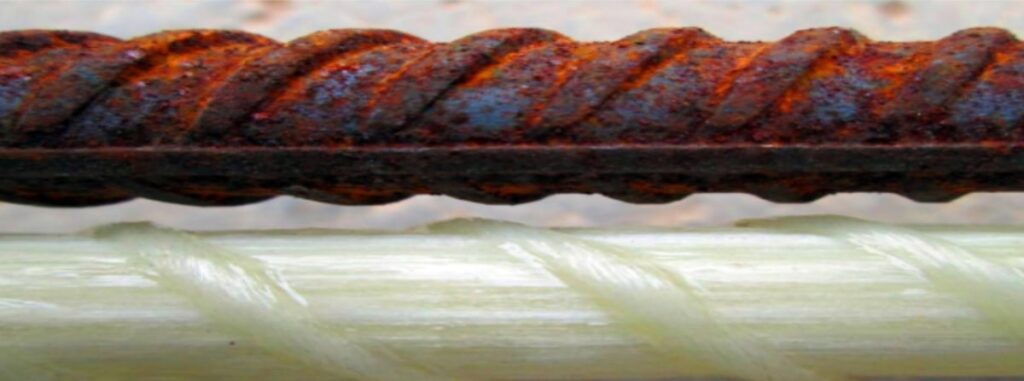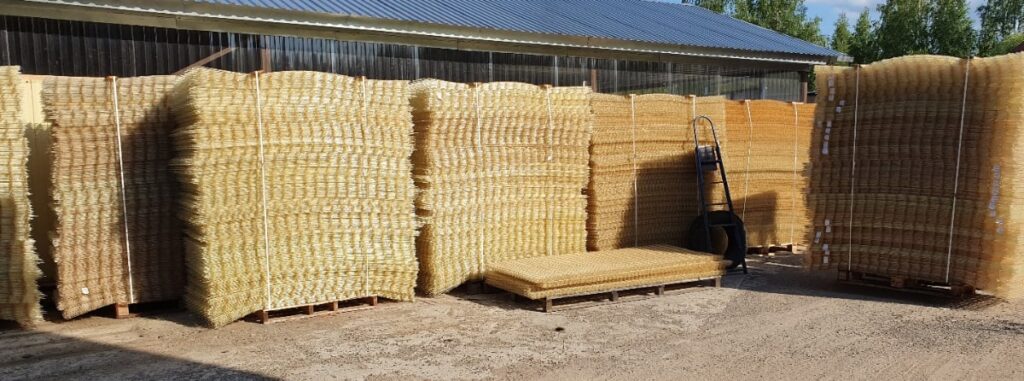لطالما كان قطاع البناء في طليعة الابتكار، إذ يبحث باستمرار عن مواد وأساليب تُحسّن القوة والمتانة والفعالية من حيث التكلفة. ومن أكثر المواد ثوريةً وتأثيرًا في السنوات الأخيرة قضبان التسليح المصنوعة من البوليمر المقوى بالألياف (FRP)، والتي غيّرت مفهوم التسليح لدى المهندسين المدنيين وخبراء البناء. دعونا نتعمق في التجارب العالمية المتعلقة باستخدام قضبان التسليح المصنوعة من البوليمر المقوى بالألياف ونفهم أهميتها.
محتوى
ما هو حديد التسليح المقوى بألياف الزجاج (FRP)؟
في جوهره، يُعدّ حديد التسليح المُدعّم بالألياف (FRP) مادةً مُركّبة مصنوعة من مصفوفة بوليمر مُقوّاة بألياف، عادةً ما تكون من الزجاج أو الكربون أو البازلت. وعلى عكس حديد التسليح الفولاذي التقليدي، يتميز حديد التسليح المُركّب بمقاومته للتآكل ونسبة قوته إلى وزنه أعلى. يُوفّر له هذا التركيب الفريد مجموعةً من المزايا التي جعلته خيارًا مثاليًا لمختلف تطبيقات البناء.
فكرة قضبان التسليح المركبة ليست جديدة. تاريخيًا، استخدمت الحضارات مواد مثل الخيزران كتعزيزات، نظرًا لمتانته ومرونته الطبيعية. إلا أن النسخة الحديثة من قضبان التسليح المركبة - قضبان التسليح المصنوعة من الألياف الزجاجية - نشأت في منتصف القرن العشرين عندما بدأ المصنعون بتجربة بدائل لتسليح الفولاذ التقليدي. كان الهدف بسيطًا: إيجاد حل لمشكلة التآكل التي عانت منها قضبان التسليح الفولاذية، وخاصة في المناطق الساحلية أو المناطق ذات المحتوى العالي من الأملاح.
التبني العالمي والتحول إلى FRP
لقد اكتسب استخدام FRP في البناء زخمًا عالميًا، والأسباب متعددة:
مقاومة التآكل: بخلاف الفولاذ، تتميز قضبان التسليح المصنوعة من البلاستيك المقوى بألياف الزجاج (FRP) بمقاومتها للتآكل. تُطيل هذه الميزة عمر الهياكل، خاصةً في البيئات المعرضة للملوحة أو التعرض للمواد الكيميائية.

وزن: تعتبر قضبان التسليح المصنوعة من البلاستيك المقوى بألياف الزجاج أخف وزناً بشكل كبير من نظيراتها المصنوعة من الفولاذ، مما يقلل من تكاليف النقل ويسهل عملية التركيب.
الحياد المغناطيسي: بالنسبة للهياكل مثل المستشفيات أو المرافق العلمية حيث يمكن أن يشكل التداخل المغناطيسي مصدر قلق، فإن استخدام البلاستيك المقوى بألياف الزجاج (FRP) يثبت أنه لا يقدر بثمن.
كانت دول رائدة مثل الولايات المتحدة الأمريكية وكندا واليابان والعديد من الدول الأوروبية في طليعة تبني قضبان التسليح المصنوعة من البلاستيك المقوى بالألياف الزجاجية. على سبيل المثال، في الولايات المتحدة الأمريكية، استخدام FRP لقد أحدثت تقنية بناء أسطح الجسور نقلة نوعية، لا سيما في المناطق الساحلية. وفي الوقت نفسه، أدركت اليابان، المعرضة للزلازل، أهمية استخدام قضبان التسليح المقواة بالألياف الزجاجية (FRP) المرنة والمتينة في هياكلها، مما يعزز قدرتها على مقاومة الزلازل.
براعة التصنيع: مصنعو قضبان التسليح البلاستيكية المقواة بالألياف الزجاجية والابتكارات
أدى ارتفاع الطلب على قضبان التسليح المصنوعة من البلاستيك المقوى بالألياف الزجاجية إلى ظهور قطاعات مخصصة مصنعي قضبان التسليح المصنوعة من البلاستيك المقوى بألياف الزجاج الذين يبتكرون باستمرار. في حين أن المبدأ الأساسي يتضمن تضمين الألياف في مصفوفة راتنجية، يستكشف المصنعون تركيبات ألياف وأنواع راتنجات وطرق إنتاج متنوعة لتعزيز قوة المنتج النهائي ومرونته.

عملية تصنيع قضبان التسليح معقدة. تُسحب الألياف المتصلة عبر حمام راتنجي لضمان تغطيتها بالكامل. ثم تُمرر عبر قالب تشكيل، ثم تُعالج إما بالحرارة أو بالأشعة فوق البنفسجية، مما يُصلب الراتنج ويُشكل قضبان التسليح.
كما يركز العديد من مصنعي قضبان التسليح المصنوعة من البلاستيك المقوى بالألياف (FRP) على الاستدامة، واستكشاف الراتنجات القابلة لإعادة التدوير والألياف المستدامة لتقليل البصمة البيئية لقضبان التسليح المركبة.
يتعلم أكثر: الأداء البيئي للبلاستيك المقوى بالألياف الزجاجية
البلاستيك المقوى بالألياف الزجاجية (FRP) مقابل الفولاذ: نظرة مقارنة
على الرغم من أن قضبان التسليح المصنوعة من البلاستيك المقوى بألياف الزجاج تتمتع بالعديد من المزايا، فمن الضروري فهم الاختلافات الدقيقة بينها وبين قضبان التسليح الفولاذية التقليدية:
قوة الشد:تتميز قضبان التسليح المصنوعة من البلاستيك المقوى بألياف الزجاج (FRP) بمتانة الشد، متفوقةً في كثير من الأحيان على الفولاذ. ومع ذلك، قد تكون معامل مرونتها أقل، مما يعني أنها أكثر مرونة.
الموصلية الحرارية: تتمتع قضبان التسليح المركبة بموصلية حرارية أقل من الفولاذ، مما يجعلها مناسبة للمناطق ذات التقلبات الشديدة في درجات الحرارة.
يكلف: للوهلة الأولى، قد تبدو قضبان التسليح المصنوعة من البلاستيك المقوى بألياف الزجاج (FRP) أغلى من الفولاذ. ولكن عند النظر إلى عمرها الافتراضي الطويل وانخفاض تكاليف صيانتها، تتضح الفوائد الاقتصادية طويلة الأجل لقضبان التسليح المصنوعة من البلاستيك المقوى بألياف الزجاج (FRP).
- حديد التسليح المقوى بألياف الزجاج مقابل حديد التسليح الفولاذي
- حديد التسليح المصنوع من البلاستيك المقوى بألياف زجاجية (GFRP) مقابل الفولاذ: التكلفة والقوة والفوائد طويلة الأمد في البناء الحديث
- حديد التسليح المقوى بألياف الزجاج (GFRP) مقابل حديد التسليح الفولاذي: مقارنة فنية
الطريق إلى الأمام: مستقبل قضبان التسليح المركبة
تشير التجارب العالمية في مجال قضبان التسليح المصنوعة من البلاستيك المقوى بألياف الزجاج (FRP) إلى مستقبل واعد. ومع ازدياد إلمام المتخصصين في مجال البناء بفوائدها، واستمرار مصنعي قضبان التسليح المصنوعة من البلاستيك المقوى بألياف الزجاج (FRP) في ابتكاراتهم، من المرجح أن يزداد استخدام البلاستيك المقوى بألياف الزجاج (FRP) في البناء.
علاوة على ذلك، مع نمو متطلبات البنية التحتية العالمية وتزايد أهمية الاعتبارات البيئية، فإن الطبيعة المستدامة وطويلة الأمد لقضبان التسليح المركبة تجعلها في مقدمة مواد التعزيز من المستقبل.
خاتمة
ال تجربة العالم مع قضبان التسليح المصنوعة من البلاستيك المقوى بألياف الزجاج يعكس هذا توجهًا أوسع في قطاع البناء: التوجه نحو مواد ليست قوية ومتينة فحسب، بل صديقة للبيئة وفعالة من حيث التكلفة على المدى الطويل. ومع تقدم التكنولوجيا وتزايد وضوح فوائد البلاستيك المقوى بألياف الزجاج (FRP)، نتوقع ازدياد أهميته في قطاع البناء العالمي.
من خلال استكشاف التاريخ، عمليات التصنيعومع التوسع العالمي في استخدام قضبان التسليح المصنوعة من البلاستيك المقوى بالألياف الزجاجية، أصبح من الواضح أن مستقبل تعزيز البناء يكمن في هذه المواد المركبة المبتكرة.

